 TheStaticTurtle
TheStaticTurtleRunning the open-source step-ca ACME server to provision SSL certificates in my homelab
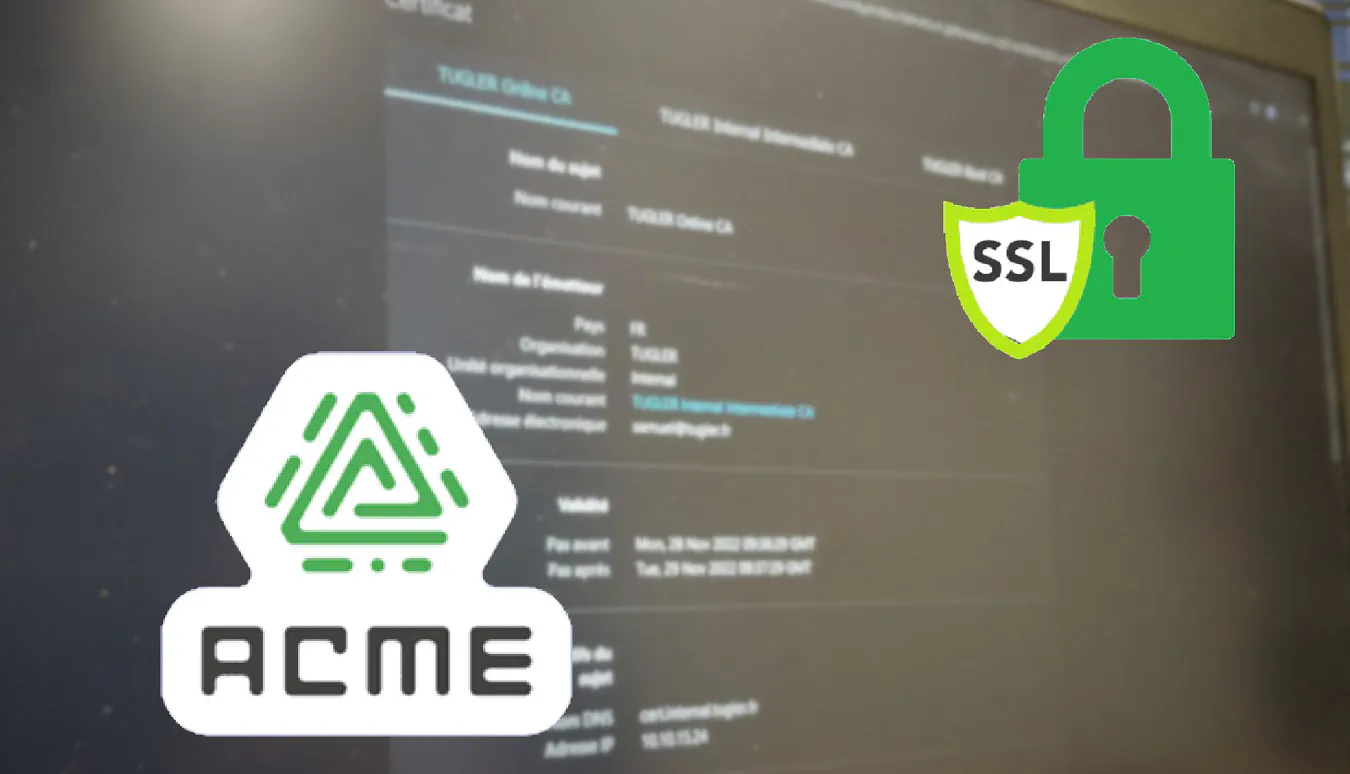
Firstly, what is an ACME: ACME means Automatic Certificate Management Environment it's a protocol for automating interactions between certificate authorities and servers, allowing the automated deployment of public key infrastructure.
Basically, it's a server that has access to a certificate authority that goes: here is a ssl certificate for domain xxxxxxx.tld to any server that can prove that it owns xxxxxxx.tld
SSL is a way to add security to a service, having a server in a homelab environment shouldn't equal to http is fine. Because it's a useful way to detect unwanted changes (MiTM attacks from hacker friends, for example) and simply a better practice. Not to mention some apps already uses SSL with no way to disable it (like proxmox) so why not do it properly.
Furthermore, it's f-ing cool 😎
Well, running a CA manually is more than fine. Except that when you reach the point where you have +20 ct/vms, you spend all your time provisioning and renewing certificates
Here is a screenshot of my XCA database, pretty full, heh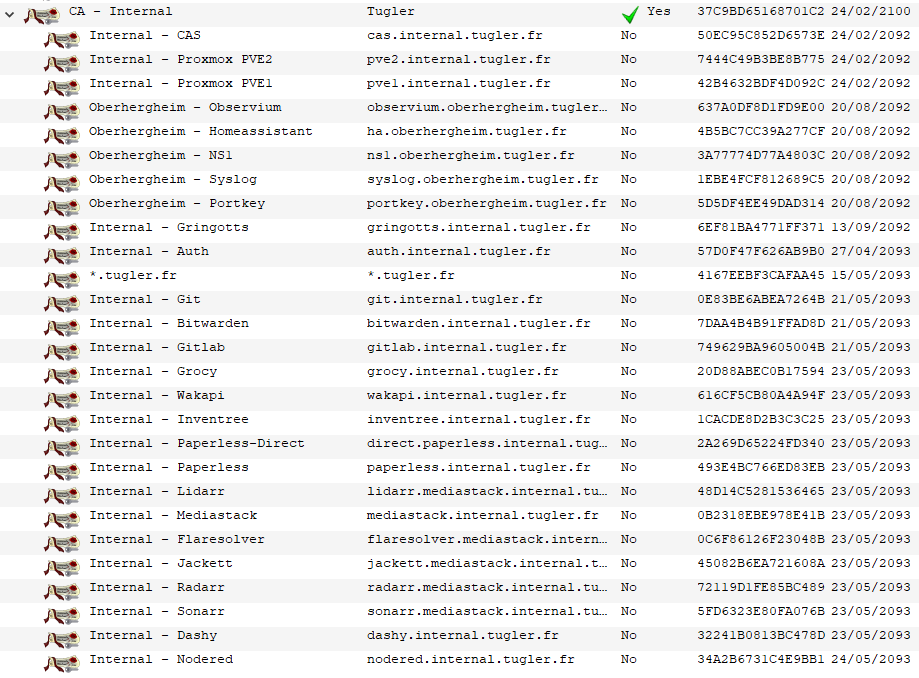
I do think that XCA is the way for small setups, as it's pretty easy to use.
But for me even certs that have a 70-year validity (which is actually an issue, see next paragraph) it's a pain to manage.
Well, for this the answer is pretty simple, Mozilla decided to reduce the validity period for TLS certs to 398 which isn't big compared to 70 years, but it's just enought for you to forget about it and go "Oh. Fuck." when every cert breaks at the same time.
Well, windows just plain sucks, I'm sure it's great when you learn all the hacks to make it work, but I want something stable where I won't spend 80h just to get a certificate. Hell, I still need to figure out why my AD just shutdowns randomly from time to time.
There isn't a ton of open-source tools that provides an ACME server, so I had the idea to build one! I actually read a significant amount of the RFC and implemented quite a bit when I discovered step-ca.
step-cais an online Certificate Authority (CA) for secure, automated X.509 and SSH certificate management. It's the server counterpart tostepCLI. It is secured with TLS, and it offers several configurable certificate provisioners, flexible certificate templating, and pluggable database backends to suit a wide variety of contexts and workflows. It employs sane default algorithms and attributes, so you don't have to be a security engineer to use it securely.
Great that look perfect and as a bonus, they have a superb tutorial for a small homelab CA
As I don't own a Yubikey, I didn't exactly follow the tutorial.
Instead, because step-ca doesn't have an easy way to customize the root and intermediate CA, I started by creating them in XCA,
The root and intermediate CA infrastructure is perfect because I actually intend to manage two sites (my lab and the small setup at my parents) and I can use different intermediate CA for both while still having one root.
Next, I run the init process for step-ca with dummy data to create the file structure/default configs
I then opened and replaced the content of:
/root/.step/certs/root_ca.crt/root/.step/certs/intermediate_ca.crt/root/.step/secrets/intermediate_ca_key/root/.step/secrets/root_ca_keyBy what I exported from XCA.
I then proceeded by running step ca provisioner add acme --type ACME which added an ACME certificate provisioner with the name acme
Next I edited the config at /root/.step/config/ca.json and added the right domains in the dnsNames array, and also edited the commonName key to something I liked.
The next step was to create a systemd service to start the acme:
1[Unit]
2Description=step-ca
3After=syslog.target network.target
4
5[Service]
6User=root
7Group=root
8ExecStart=step-ca
9Type=simple
10Restart=on-failure
11RestartSec=10
12
13[Install]
14WantedBy=multi-user.target
After running:
1root@cert.internal:~# systemctl enable step-ca.service ce
2root@cert.internal:~# systemctl start step-ca.service
I had my server up and running.
So, now that we have an ACME server, we need to actually use it.
First server I updated is my auth server. It uses Caddy as a reverse proxy according to the step-ca docs you need to pass the root ca as an environment variable. However, I would rather not deal with it with docker, so my config looks like this:
1auth.internal.tugler.fr {
2 tls {
3 ca https://cert.internal.tugler.fr/acme/acme/directory
4 ca_root /etc/caddy/root_ca.pem
5 }
6 reverse_proxy authelia:9091
7}
1 server:
2 image: caddy
3 ports:
4 - '80:80'
5 - '443:443'
6 volumes:
7 - './Caddyfile:/etc/caddy/Caddyfile'
8 - './root_ca.pem:/etc/caddy/root_ca.pem'
9 restart: unless-stopped
I proceeded by restarting the stack, and it worked the first time: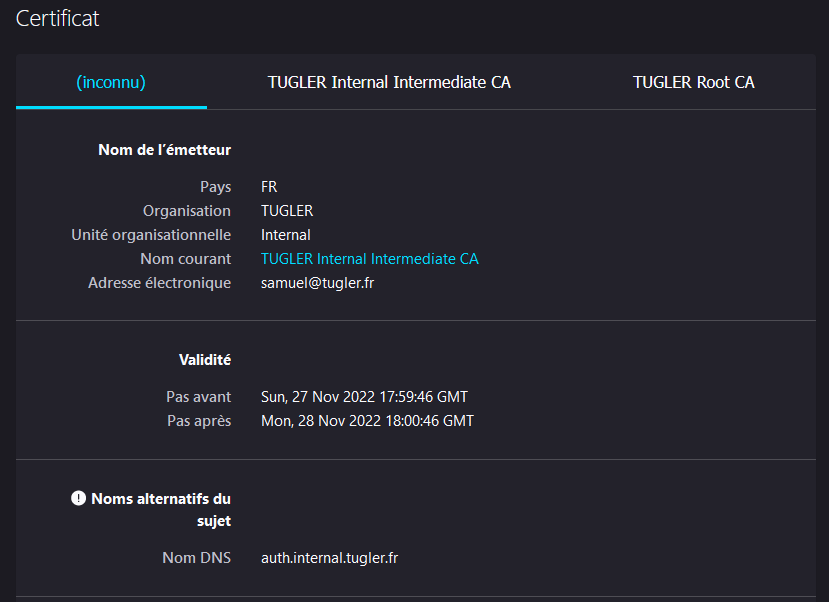
Nice 😃
The process for certbot is simple, I just need to add the --directory https://cert.internal.tugler.fr/acme/acme/directory argument to the command to tell it which server to use
After looking at the cert a bit closely, I need to modify the certificate templates for the provider to add the CN and other things since they are empty for now, but it already works with very minimal effort.
Now that we have everything running, we have to tell our clients to actually trust the CA. Pretty easy, you would think? Well, not so, depending on the platform!
Windows is easy, just import the certificate to the Machine "Certification Authority" store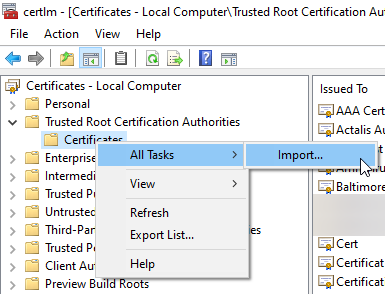
Chrome takes the certificate from the Windows store, so that's done!
Firefox, as always, is again doing things differently, so you have to go into the options and import it there as well.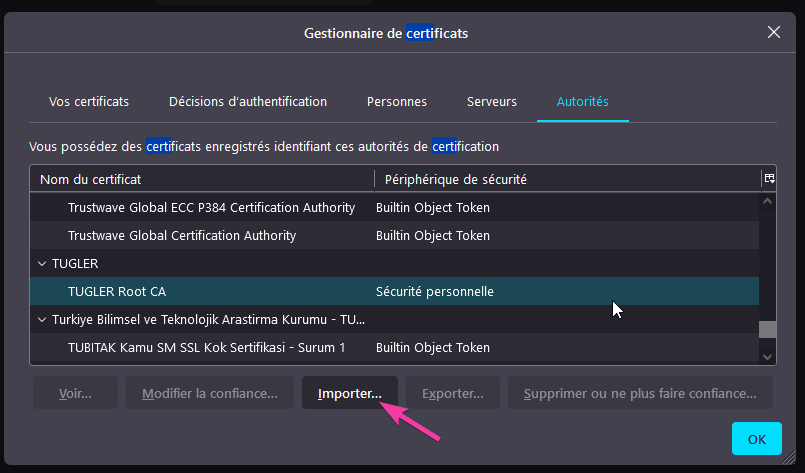
I use some Ansible script to manage my servers, so it was as simple as creating a new role for the server that needs the root ca, coping the file adding the role to my "common" playbook:
1---
2- name: Make sure the folder exists
3 file:
4 path: /usr/local/share/ca-certificates
5 state: directory
6
7- name: Copy the certificate
8 copy:
9 src: "files/tugler_ca_root.pem"
10 dest: "/usr/local/share/ca-certificates/tugler_ca_root.pem.crt"
11 register: result
12
13- name: Update CA Trust
14 command: update-ca-certificates
15 when: result is changed
Android …., what a nightmare, it's so annoying it's actually incredible 😤. First thing you need to know is that it's not called certificates it's called credentials, good luck finding it in the settings. Moreover, there are two certificates store, the user store and the system store. The system store contains the root CA and the user store generally contain user credentials for thing like VPNs.
Importing the certificate to the user store is actually straightforward, download the cert, enter your pin, give it a name, and it's done.
However, I want to use apps like paperless ingest, HomeAssistant, Bitwarden, grocy, ..... And guess what, apps want the certificate in the system store.
I'm sure you could do this properly in a managed setup. However, I don't have time to manage that, and my phone is already rooted, so how can we do it?
Turns out, you can either do it manually each time you reboot by moving files around, or you can use a magisk module that does just that:
I proceeded by reading the script (always do this before randomly giving root access to something you don't trust), installed it, rebooted and boom here it is: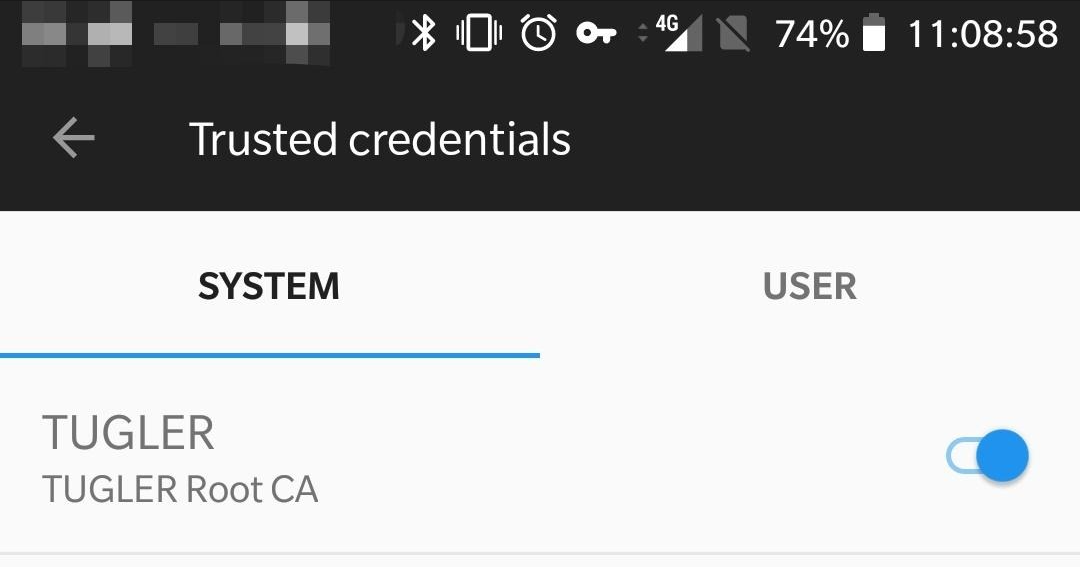
And you know what? It actually worked: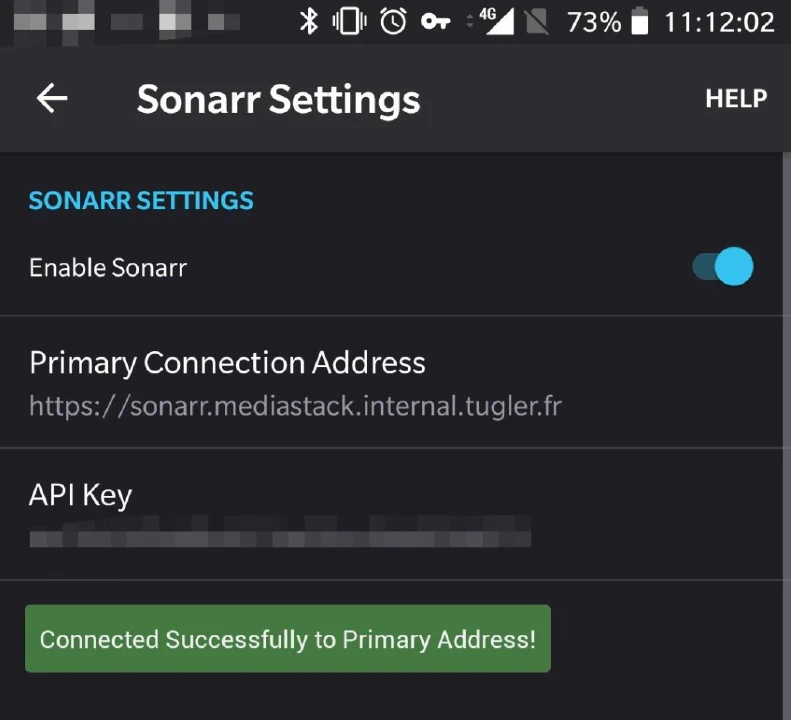
You would think it would be easy, right? That Firefox would just work? 🤡
Guess what, Firefox doesn't use system or user provided certificate by default. You have to go into the "Secret Settings" to enable it.
So to make Firefox trust my CA, I have to:
Chrome is a system app, right? So, it should just work, right? 🤡 Well, it did until a few years ago, when they started to require certificate transparency.
What the hell is certificate transparency in the first place? From what I understand, it means that there are public servers that log the certificates changes of public websites when they are issued from well-known CAs. And that chrome queries at least two of these server them to check that it's still valid. Seems pretty useful.
AdGuard has a page explaining it a bit: https://kb.adguard.com/en/general/https-filtering/https-filtering-known-issues
Unfortunately, nor my CA, nor my website is public, so what do I do?
It turns out that because it's in the system store, chrome thinks it's a well trusted CA 😶 and wants to verify it, bummer! It can use the one in the user store, but will prioritize the system store.
So, what do you do? Apparently, there is a way to do it properly use a managed setup (again) and manually telling chrome that this cert doesn't need to be verified Or, you hide the one in the system store from chrome.
Chrome doesn't need root anyway, so I choose to hide it, in magisk I had to:
ZygiskEnforce DenyListAfter doing all this and force closing chrome, ignoring the pop-up about installing a CA on first load 🤨, my CA was now valid: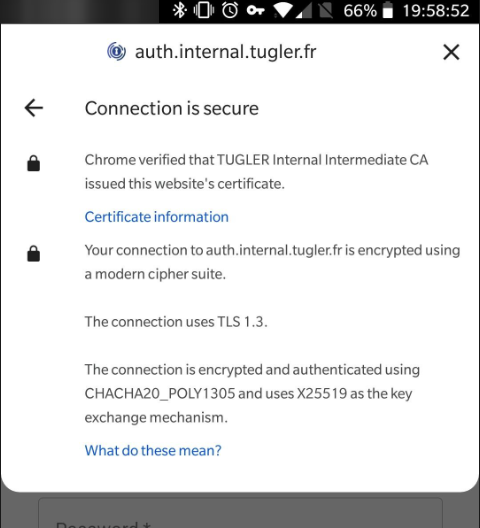
This shouldn't be a problem for non-rooted phones anyway because you wouldn't be able to add it to the system store in the first place.
Well, it was quite an adventure, but now I hopefully don't have to worry about certificates, until the intermediate one expires in 2032 at which point I can just renew and certs will be re-issued automatically. Great 😄
There are two things I'm not happy about, tho:
Want to chat about this article? Just post a message down here. Chat is powered by giscus and all discussions can be found here: TheStaticTurtle/blog-comments